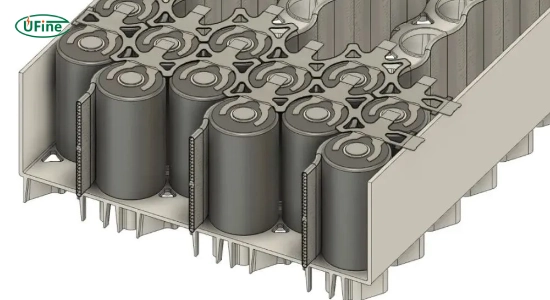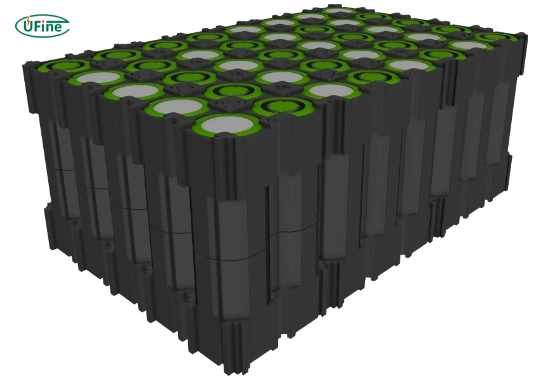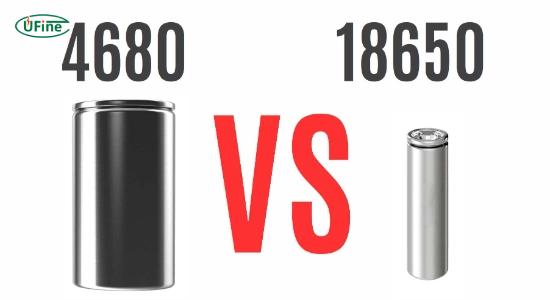The 4680 battery cell represents a significant advancement in battery technology, particularly in the electric vehicle (EV) industry. As automotive manufacturers strive for greater efficiency and performance, understanding how the 4680 battery cell compares to the traditional 18650 battery is essential. This article will explore both battery types’ characteristics, advantages, disadvantages, and applications, providing a comprehensive comparison highlighting their unique features.
Part 1. What are 4680 batteries?
The 4680 battery is a cylindrical lithium-ion cell introduced by Tesla. It measures 46mm in diameter and 80mm in height, which gives it its name. This innovative design allows for greater energy density and efficiency than smaller cells like the 18650.
Key Features of 4680 Batteries
- Higher Energy Density: The 4680 cell can store more energy per unit volume than its smaller counterparts. Electric vehicles using these batteries can travel further on a single charge.
- Improved Manufacturing Efficiency: Tesla’s production methods for the 4680 battery aim to reduce costs and increase output. A streamlined manufacturing process integrates various steps to achieve this.
- Enhanced Thermal Management: The 4680’s design facilitates better heat dissipation, crucial for maintaining performance and safety during operation. This feature helps prevent overheating, especially during rapid charging or high-performance driving.
Part 2. What are 18650 batteries?
The 18650 battery, named for its dimensions of 18mm in diameter and 65mm in height, has been a staple in many consumer electronics since its introduction. People widely use it due to its capacity, size, and safety balance.
Key Features of 18650 Batteries
- Established Technology: The 18650 battery has been around for many years and has a well-documented performance history. This reliability makes it a popular choice among manufacturers.
- Versatile Applications: The 18650 is known for its dependability in various devices, and it is commonly found in laptops, flashlights, and electric vehicles.
- Safety Features: These batteries often include protective circuits to prevent overcharging and short circuits, enhancing their safety profile.
Part 3. Size comparison: 4680 cell vs. 18650
The 4680 battery cell is significantly larger than the 18650 battery, measuring 46mm in diameter and 80mm in height, compared to the 18650’s dimensions of 18mm in diameter and 65mm in height. This size difference allows the 4680 battery to store more energy, with capacities reaching up to 8000mAh, while the 18650 battery typically holds up to 3500mAh. Consequently, fewer 4680 cells are needed in electric vehicle battery packs, simplifying manufacturing and potentially reducing costs. Below is a detailed comparison of their dimensions and specifications:
| Feature | 4680 Battery | 18650 Battery |
|---|---|---|
| Diameter | 46 mm | 18 mm |
| Height | 80 mm | 65 mm |
| Volume | Approximately π×(23)²×80≈85,000 cubic mm | Approximately π×(9)²×65≈1,500 cubic mm |
| Capacity | Up to 8000mAh | Up to 3500mAh |
| Voltage | Typically around 3.7V | Typically around 3.7V |
| Weight | Heavier, around 100g | Lighter, around 50g |
| Cycle Life | Approximately 1000-2000 cycles | Approximately 1500-4000 cycles |
This comparison underscores how the size and capacity differences between the two batteries affect their applications and performance in various devices.
Part 4. Capacity and energy density: 4680 cell vs. 18650
Capacity is a critical factor when evaluating battery performance:
- 4680 Battery Capacity: Typically rated up to 8000mAh, enabling longer usage times between charges. This high capacity is particularly beneficial for electric vehicles that require extended range capabilities.
- 18650 Battery Capacity: Generally, it ranges from 1200mAh to 5000mAh, depending on the specific model. While some high-capacity versions exist, they still need to catch up to the potential of the 4680 battery.
This difference means electric vehicles using 4680 batteries can achieve greater ranges on a single charge than 18650 batteries.
Part 5. Cycle life: 4680 cell vs. 18650
Cycle life refers to the number of charge-discharge cycles a battery can undergo before its capacity significantly diminishes:
- 4680 Battery Cycle Life: Approximately 1000 to 2000 cycles, depending on usage conditions. While this is decent, applications requiring long-term reliability need more.
- 18650 Battery Cycle Life: This battery can reach up to 4000 cycles, making it suitable for durability and longevity applications. This extended cycle life means users can rely on these batteries for longer without needing replacements.
While the 4680 battery offers higher initial capacity, the 18650 battery’s longer cycle life makes it a dependable choice for many users who prioritize longevity over capacity.
Part 6. Performance metrics: 4680 cell vs. 18650
Performance metrics such as charge rate and discharge rate are essential for understanding how these batteries operate under load:
- Charge Rate: The larger surface area of the 4680 battery benefits from lower internal resistance, allowing for faster charging compared to the 18650 battery, which may take longer due to its smaller size and higher resistance.
- Discharge Rate: Both batteries can deliver high discharge rates; however, the 4680 cell’s larger capacity allows it to maintain performance over extended periods without overheating. This characteristic is significant for applications requiring high power output.
Part 7. Applications of 4680 cell and 18650
The applications for these two types of batteries vary significantly based on their characteristics:
Applications of 4680 Batteries:
- Primarily used in electric vehicles (EVs), particularly by Tesla.
- Potential future applications include energy storage systems due to their high capacity and efficiency.
- Their design may also enable new applications in robotics or drones where weight-to-power ratios are critical.
Applications of 18650 Batteries:
- Widely used in consumer electronics such as laptops, cameras, flashlights, and power tools.
- Also found in electric vehicles but typically as part of larger packs composed of many cells.
- Their established presence makes them suitable for various devices where reliability is paramount.
Part 8. Advantages of 4680 cell and 18650
Both batteries have unique advantages that cater to different needs:
Advantages of 4680 Batteries
- Higher energy density leads to longer ranges for electric vehicles.
- Reduced manufacturing costs due to fewer cells needed per pack make them economically attractive for large-scale production.
- Enhanced thermal management improves safety and performance under load, making them suitable for high-performance applications.
Advantages of 18650 Batteries
- Longer cycle life makes them ideal for applications requiring durability over time.
- Established safety protocols reduce risks associated with use; users have confidence in their reliability.
- The versatility across various devices enhances their appeal; users can use them in everything from flashlights to EVs without significant modification.
Part 9. Disadvantages of 4680 cell and 18650
While both batteries have strengths, they also come with drawbacks:
Disadvantages of 4680 Batteries
- Currently limited primarily to electric vehicle applications, their adoption outside this sector is still developing.
- A shorter cycle life compared to the established performance of the 18650 battery may deter some users looking for longevity.
Disadvantages of 18650 Batteries
- Lower energy density means more cells are needed for high-capacity applications, which can lead to increased device weight and size.
- Size limitations can restrict their use in compact designs compared to newer technologies like the 4680 battery, which offers more flexibility in design options.
Part 10. FAQs
-
What is the main difference between a 4680 battery and an 18650 battery?
The primary difference lies in size and capacity; the 4680 battery is larger and has a higher energy density than the smaller but more established 18650 battery. -
Which battery type lasts longer?
Generally, the 18650 battery has a longer cycle life (up to 4000 cycles) compared to the shorter lifespan (1000–2000 cycles) of the 4680 battery. -
Can I use a 4680 battery instead of an 18650?
They are only interchangeable with significant modifications due to their different sizes and design specifications. -
What applications are best suited for each type?
Due to its high capacity, the 4680 battery is ideal for electric vehicles, while the versatile 18650 battery is used in various consumer electronics. -
Are there safety concerns with either type?
Both types have safety features; however, established protocols make the 18650 battery generally perceived as safer due to its long history in diverse applications.
Related Tags:
More Articles

How to Choose the Best Floor Scrubber Battery for Commercial Cleaning?
Selecting the ideal floor scrubber battery ensures a long runtime, rapid charging, and minimal maintenance for efficient commercial cleaning operations.
Battery for Blower vs Battery for Leaf Vacuum: Which One Should You Choose?
Battery for blower vs leaf vacuum—learn the key differences in power, fit, and runtime to choose the right battery for your outdoor tool needs.
How to Choose the Right Battery for Blower?
Choosing the right blower battery? Consider voltage, capacity, chemistry & usage. This guide helps match the best battery for peak performance.
How to Choose the Best Insulated Battery Box for Lithium Batteries?
Choosing the Best Insulated Battery Box for Lithium Batteries? Discover key factors such as size, material, and safety for optimal protection and performance.
7 Critical Elements on a Lithium Battery Shipping Label
What must be on a lithium battery shipping label? Learn 7 key elements to ensure safety, legal compliance, and correct handling across all transport modes.






